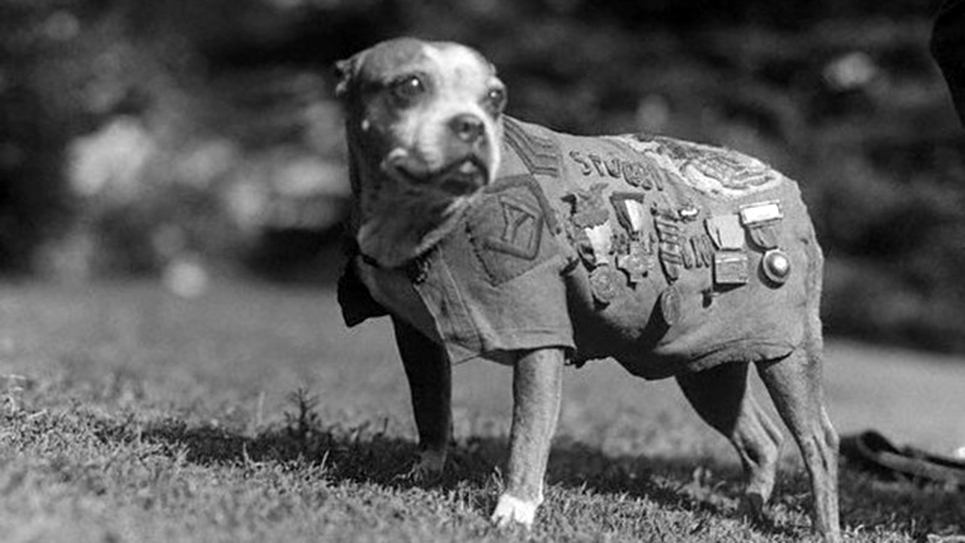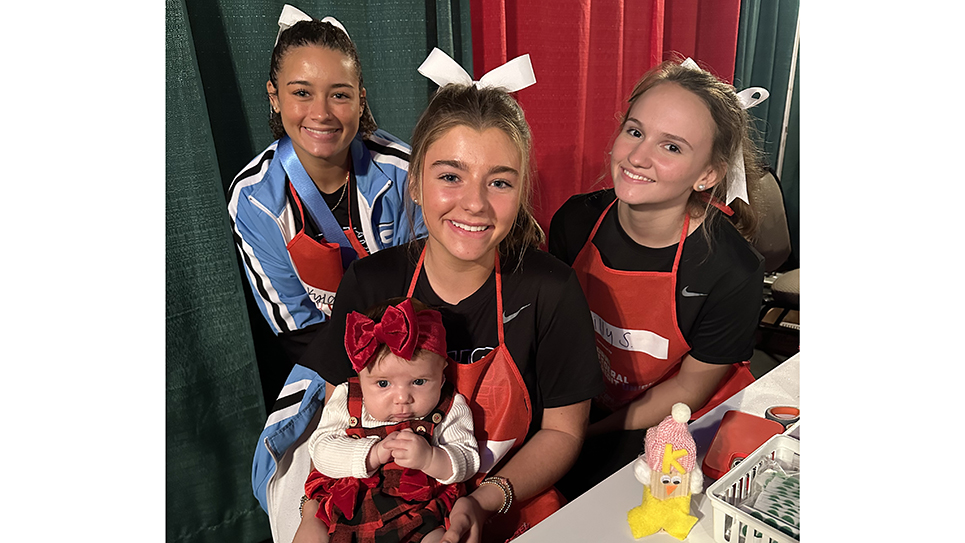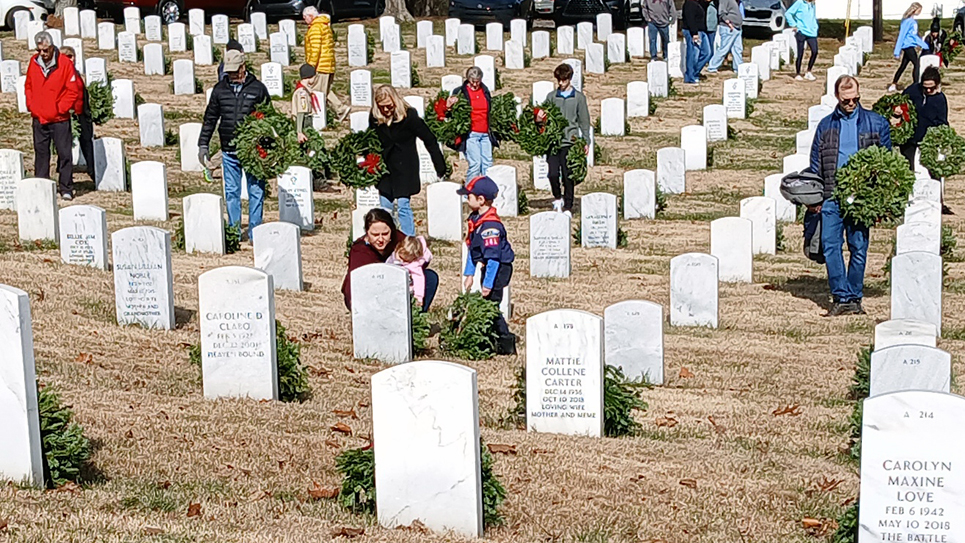‘Stubby’
A Hero of the Great War
By Ray Hill
Faithful readers of this column know of my great love for dogs, and I cannot count the number of times people have told me how much they like it when I write about animals. I have long contended that the dog is God’s most perfect creation in terms of the kind of unconditional love that the Lord Himself bestows upon His children. Loyal and true to the last beat of their hearts, dogs are indeed man’s best friend.
Woodrow Wilson had been reelected president largely due to his slogan, “He Kept Us Out of War,” but the United States entered the First World War in 1917. It remains one of the bloodiest wars in human history. Much was written about Stubby, who was variously described as an “American bull terrier,” a “Boston terrier,” and a dog of “uncertain breed.” Stubby’s escapades filled the pages of newspapers across the country and found a public eager to read more about the courageous pup. Recounting the story of Stubby is, as is any tale involving a dog, one of loyalty, trust and love.
The stray dog became an American celebrity, meeting three presidents of the United States and receiving a lifetime membership in the American Legion. For a time, Stubby took to the stage for vaudeville. Stubby’s passing was duly noted with a half-page obituary printed in no less than the New York Times.
The Great War, as it was called at the time, saw several deadly weapons used for killing, including flamethrowers, tanks, mortars and airplanes. Grenades were improved and more widely used, and machine guns were perfected for mass slaughter. That same slaughter reaped countless lives as the young flower of manhood charged from one set of trenches toward that of the enemy into a hail of machine gun and artillery fire for an entirely new level of killing. Stubby received so much attention because of the sheer terribleness of the First World War as much as for Americans’ love of dogs. Stubby was one of the very few good things about the war.
Stubby was allegedly promoted to the rank of “Sergeant,” which may be an invention of Hollywood fiction writers. When the pup passed away, there was much written about his eventful life, but I never saw any mention of his having been made a sergeant. Ann Bausum, who has written two books about Stubby, doesn’t think it’s true. Ms. Bausum searched far more newspaper articles than I did and saw no mention of the little dog making the rank of sergeant. What is most certainly true is enough to satisfy anyone, for it is absolutely certain that Stubby won several medals for his bravery, comforted the wounded, rescued soldiers, captured a German spy, and was himself wounded at least three times in battle. When wounded by a shell or grenade by retreating German soldiers, like any soldier, Stubby was hurried to a Red Cross hospital where he recovered. As Stubby recovered, he helped to raise the spirits of other soldiers who had been wounded and was highly popular with his mates. Once fully recovered, Stubby went back to the trenches.
A gold medal awarded by the American Humane Society was pinned to Stubby’s uniform by the commander of the American Expeditionary Forces, General John J. “Black Jack” Pershing. Stubby lived to be a veteran and was a regular at the conventions of the American Legion and usually led the parades of former soldiers proudly marching.
Stubby was found trolling the grounds of Yale University, which is where the members of the 102nd Infantry were training before going overseas. To this day, there are news stories and videos about American soldiers finding strays and bringing them home. Stubby’s own story is a bit different; he left his home in the United States and went to war.
As is always the case when someone is friendly to a dog, the dog becomes omnipresent. Stubby was no different, and as the American troops drilled at Yale, Stubby became a constant presence moving through the ranks of the troops. One soldier in particular took a liking to Stubby and looked after him, Corporal James Robert Conroy, a 25-year-old from New Britain, Connecticut. The kind-hearted Conroy took Stubby into his care, and when it came time for the men to be shipped across the Atlantic Ocean, the young man found he couldn’t leave his newfound friend behind. Somehow, Stubby never caught the attention of the higher-ups on the troop ship, and Corporal Conroy managed to sneak the dog off the ship by hiding him beneath his overcoat. Legend has it, when Stubby was finally noticed by the corporal’s commanding officer, Stubby saluted, a trick he had been taught by the soldiers. That was enough to keep Conroy and Stubby together. Stubby had become the mascot of the 102nd Infantry.
Dogs uncomplainingly share whatever fate befalls their owners, and Stubby lived in the trenches in France with Corporal Conroy and the men of the 102nd Infantry for a year and a half. Stubby persevered through the worst of it, enduring those terrible times when the soldiers of the 102nd Infantry were under heavy enemy fire ‘round the clock for more than a month.
Life in the trenches during the Great War was brutal. There were long periods where soldiers were bored out of their minds and times of mind-numbing terror during the fighting and while artillery fire rained down upon them. The living conditions were awful, and soldiers frequently slept little in addition to the natural stress of not knowing what might come within the next few minutes. Exhaustion was a constant companion, as were rats, lice and other vermin. Sewage overflowed from what toilets were available, soldiers were frequently covered with mud and slime during the heavy rains, and trench foot was common. Stubby remained a source of amusement and comfort to the soldiers inside the trenches, a friend who shared their deprivations and suffering.
Stubby was also a victim of mustard gas, one of the more ghastly innovations of the First World War, but fortunately, he recovered. Stubby’s fellow soldiers made certain he was protected from future gas attacks by making him his own specially constructed gas mask. What his mates didn’t realize was that Stubby would become remarkably adept at warning them of coming gas attacks. According to the New York Times, Stubby’s keen nose saved the lives of an entire company of soldiers by raising a ruckus and alerting them of a coming gas attack by the Germans.
Stubby also wandered into the deadly “no man’s land” between the opposing trenches, where the brave little stray helped to locate wounded soldiers. The Military Times quoted Curt Deane, the grandson of Robert Conroy, who said, “My grandfather was always clear: He was a service dog. He gave the troops comfort; he gave them support. He used to run through the trenches and warn them about gas attacks. He used to go outside of the trenches into this sort of no-man’s land, between the U.S. and German trenches, and stand by soldiers who had been injured until the medics could come and get them.”
Deane also related that Stubby went AWOL occasionally. “Stubby would disappear for weeks at a time and the guys would kind of have no idea where he was, and there was this whole fear that he had been killed or whatever. My grandfather would say, ‘He always came back with his head held high and his stubby tail up in the air,’ and knew right where my grandfather was,” Deane said.
Curt Deane thought that was quite a feat of its own. “It was amazing,” he told the Military Times, “And these troops wouldn’t stay still – – – they were moving around, but he always came right back and knew exactly where my grandfather was.”
Likewise, due to his vastly superior hearing, Stubby was able to hear the incoming shells fired by enemy guns before others, which alerted them to seek cover. The media of the time made much of Stubby having captured a lurking German spy, for which the commander of the unit sought to give the canine soldier a promotion to the rank of sergeant. The New York Times related the story of Stubby capturing the German spy. The ever-vigilant Stubby heard something suspicious and crept out of the trenches, where he found the German, who attempted to fool the dog. Stubby responded by grabbing the German by the seat of the pants and growling ferociously. Fellow soldiers followed Stubby and took the spy prisoner. They also took the German’s Iron Cross medal and awarded it to Stubby.
Grateful French women hand-sewed a coat for Stubby so that he could be seen with the array of medals he had earned.
When Stubby passed away, it was front-page news in some of the biggest newspapers in America. Stubby lived out his life with Corporal Conroy, who was the chief of staff for Congressman Edward Hart Fenn of Connecticut. Stubby even attended law school with Conroy. Dogs were prohibited from living in the university dormitories, but Corporal Conroy showed university administrators the clippings of Stubby’s service during the Great War, and an exception was made. Conroy was also employed by the Federal Bureau of Investigation while attending law school as a special agent.
Stubby became almost as well-known at Georgetown University in Washington, D.C., as he had been by the members of the 102nd Infantry. Neil Moriarty, a fellow student at the time, recalled being astonished by “the almost human intelligence” exhibited by Stubby. The dog became a mascot for Georgetown University. In addition to the American Legion, Stubby held honorary memberships in the YMCA and the American Red Cross.
After an adventurous life of ten years, Stubby went to sleep and never awoke in this world. That was according to some of the contemporary news stories of the day. Others indicated Stubby died in the arms of Robert Conroy.
Stubby’s earthly remains were preserved through the art of taxidermy, and his ashes were placed inside the body. J. Robert Conroy later presented Stubby to the Smithsonian Institute. Some thirty years after Stubby’s passing, Conroy posed along with fellow World War I veteran and Tennessee Congressman Carroll Reece for a picture beside Stubby at the Smithsonian.
Corporal Conroy never forgot his friend Stubby and made certain the brave little stray dog would never be forgotten. A statue of Stubby was dedicated in Middletown, Connecticut, at the Veterans’ Park in 2018. Stubby’s life and legend were made for the movies, and Hollywood released an animated film recently about the canine hero. If Hollywood exaggerated as it invariably does in telling Stubby’s story, it is one instance where those of us who love dogs know the little stray was quite capable of everything credited to him.
There is still a program that sends dogs into Walter Reed Medical Center to visit with the soldiers getting treatment there. Curt Deane remembered his grandfather’s story about Stubby, and it was abundantly clear Robert Conroy never let go of the little stray dog’s memory.
“I used to ask him why he never got another dog,” Deane said, “and he made it very clear to me that Stubby was so special and so unique that he just couldn’t imagine another dog being able to fill that role.”
Robert Conroy extracted a promise from his grandson to do all that he could to keep Stubby’s memory alive.
Stubby exemplified those attributes that all of us who love canines realize they share: a heart and spirit as big as all outdoors and an endless devotion to their family and friends. The only thing greater is the Lord God Himself.
© 2025 Ray Hill







